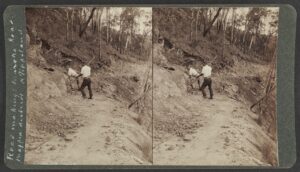Geographer Peter Cabena, originally resident of Victoria, completed a Masters dissertation in 1980 on the grazing of cattle in the Victorian high country, having conducted a deep dive into state government archives, and a significant round of interviews with mountain district cattlemen and others. The original thesis can be viewed at https://www.highcountryhistory.org.au/historical-item/grazing-the-high-country-victoria-an-historical-and-political-geography-of-high-country-grazing-in-victoria-1835-to-1935/.
Peter returned to the subject in 2014 to review, refine & expand the scope and content of his research, finally calling time out on his efforts on 4 February 2025, when he passed it to the Secretary of PaRC for uploading.
PaRC is delighted to have the privilege of publishing this monumental work with its snapshot of the views of people affected by a highly controversial and widely discussed issue of land-use and park management. Being a research dissertation not formally published in the scholarly literature this work has, until now, remained relatively unknown to the broader community.
If any part of this publication breaches copyright or privacy, please be assured by the author and PaRC that this is inadvertent; and don’t hesitate to let the Secretary know so that the breach can be rectified.
First published 17 Sep. 2025. Minor editorial corrections and pagination 7 November 2025. Proofreading for consistency of style has not been completed.
INVITATION TO COMMENT
Peter Cabena offers to readers the opportunity to comment on any perceived factual errors or issues regarding interpretations.Please submit to PaRC via secretary AT SYMBOL parcaustralia.com.au.
TABLE OF CONTENTS
INTRODUCTION
ABBREVIATIONS & DEFINITIONS
LIST OF FILES WITH SIZES
CHAPTER 1: PASTORAL EXPLORATION & EXPANSION
a) Background
b) Settlement of the Alpine Periphery
c) Exploring the Snow Country
d) Pioneer Mountain Grazing
e) Gold Discoveries and the Rise of Smaller Scale Pastoralists
CHAPTER 2: HOW THE ADMINISTRATION OF LAND TENURE INFLUENCED SNOW COUNTRY GRAZING
a) The Necessity for and Consequences of a Land Tenure System
b) The Impact of Land Selection
c) The 1878 Crown Lands Commission
d) The 1884 Land Act
e) Long Term Increase in Pastoral Occupation after 1884
CHAPTER 3: LATER LAND SETTLEMENT DREAMS AND SCHEMES
a) Land Selection in the Snow Country
b) Land Settlement Schemes
c) Tourism
CHAPTER 4: HOW GRAZIERS USED THE SNOW COUNTRY
a) Cattle Country
b) The Number of Snow Country Graziers
c) Trends in Stocking Levels
d) Drought Relief Grazing
e) Common Practices and Structures
f) Social Capital
CHAPTER 5: A TRADITIONAL PASTORAL ECOLOGY (AN APPLIED PASTORAL ECOLOGY, AND LANDSCAPE CHANGE)
CHAPTER 6: PUBLIC INTERESTS, PUBLIC VALUES AND PUBLIC PURPOSE LAND RESERVATIONS
CHAPTER 7: (WINDING DOWN): CHANGING SOCIAL, ECONOMIC AND ENVIRONMENTAL CIRCUMSTANCES
CHAPTER 8: EPILOGUE
APPENDICES
A. LOCAL HISTORIES
Western Fringe
Buffalo Platea
Upper Goulburn River Watershed
Baw Baw Plateau
Central Core
The Greater Bogong High Plains
The Snowy Range & Dargo High Plains
Far East
The Snowy – lndi Divide
Nunniong Plateau
B. EXPOSING FERDINAND MUELLER’S MISLEADING CLAIM
D. LIST OF SNOW COUNTRY GRAZING RUNS AND THEIR OCCUPANTS. (Note: this is an Excel file. If it does not transmit successfully, please let PaRC know).
E. SHEEP GRAZING IN THE SNOW COUNTRY AS RECORDED IN THE ORAL HISTORY
F. NOTES OF INTERVIEWS WITH SNOW COUNTRY GRAZIERS, 1975-1978 (128 pages).









